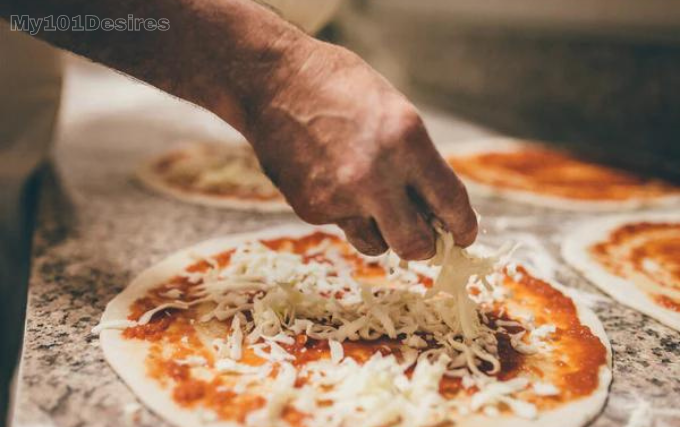Few foods can compare to pizza’s worldwide appeal when it comes to comfort food. With options like traditional Margherita or loaded meat lovers, there’s a pizza to suit everyone’s taste. In this blog, we’ll explore pizza’s diverse flavors, making it a global culinary favorite. Greetings and welcome to The Pizza Edition, where we share the techniques for making the ideal slice.
The Origin Story of Pizza – A Journey Back in Time
Pizza’s origins trace back to ancient civilizations, where simple flatbreads with toppings foreshadowed today’s beloved dish. This basic food item was a mainstay of the diets of people living in the Mediterranean Basin, suggesting a long history behind pizza.
Pizza evolved from its earliest versions to its modern form on Naples’ vibrant streets in the 18th century. With the invention of the Neapolitan pizza, pizza started to take on its own unique personality at this point. A straightforward yet powerful combination of tomato, mozzarella, and basil on top of a thin, crispy crust, it signaled the start of a period that would see pizza become a worldwide sensation.
This Neapolitan invention, which combined simplicity and rich flavor, set the culinary standard for what pizza would eventually become. Pizza’s evolution from ancient flatbreads to Neapolitan staple transformed its shape and flavor, spreading globally, spawning diverse styles.

Decoding the Types – A Guide to Pizza Styles
Exploring pizza types unveils a universe where each variety possesses a unique personality and taste profile. A Chicago deep-dish pizza’s thick, meaty base contrasts with the crispy, thin crust of a New York-style pizza, demonstrating the adaptability of pizza dough as a medium for culinary expression. Neapolitan pizza, with its smoky flavor and charred bubbles from a wood-fired oven, evokes Naples’ bustling streets.
St. Louis-style pizza features a cracker-like crust and tart Provel cheese, showcasing regional tastes’ influence on pizza identity. Pizza in the Detroit style, with its thick, chewy crust and distinctive cheesy caramelized edges that produce a play of textures and tastes, is a good option for adventurous palates.
Each pizza style, a reflection of community preferences and inventions, signifies a unique chapter in global pizza history. Examining various approaches encourages a greater understanding of the creativity and cultural diversity infused in each slice, in addition to a culinary journey.
The Art of Pizza Making – Techniques and Tips
Learning how to make pizza is a journey that starts with the basics: the dough. The quality of the dough, which requires exact hydration, careful flour selection, and skillful kneading, determines the success of the crust. An extensible base that can withstand a substantial amount of toppings without ripping is guaranteed by well-kneaded dough. The fermentation process is the next crucial stage, and patience is essential.
Dough flavor and texture improve with proper temperature for resting and rising, enhancing the pizza experience. The objective of stretching the dough is to generate an even thickness foundation, which encourages consistent cooking. Here’s where skill really counts: rolling the dough with a rolling pin might compress it too much, but stretching it by hand keeps the air bubbles in place and creates a delicate, airy top. Securing the ideal baking is yet another crucial component.
Achieving golden crispness demands precise temperature and cooking time, whether on a stone, wood-fired, or conventional oven. In order to avoid a soggy bottom, the order in which toppings are applied also influences the final product. A balance between wetness and dryness should be considered. Your greatest friends when it comes to honing the art of cooking pizza are practice and experimentation.

Toppings Galore – Crafting the Perfect Combination
Navigating pizza’s vast topping options is a culinary art, inspiring endless innovation and personalization in this gastronomic journey. The precise interaction of salty, sweet, spicy, and acidic ingredients is the key to creating the ideal combo. Every topping on a the pizza edition needs to work in harmony with the others to create a cohesive taste profile that satisfies the palate with every bite.
Bold and well-balanced flavor may be achieved by combining the sweetness of caramelized onions with a dash of spicy pepperoni. Similar to this, the sharp acidity of fresh tomatoes and the earthiness of mushrooms combine to create a rich, crisp taste depth.
Venturing into new realms with toppings like goat cheese, arugula, or figs elevates basic pizza to gourmet status. Pizza is magical not just because of its ingredients, but also because of the way they combine to create a mouthwatering narrative. Remember, exceptional the pizza edition hinges not just on toppings quantity but on the perfect blend that enhances and fulfills.
The Cultural Impact of Pizza – More Than Just a Meal
Pizza is a worldwide language of comfort and connection, embodying a certain kind of social phenomena. This culinary mainstay serves as more than just a dish; it’s a lively thread that ties people from different origins together during social occasions. Pizza, a staple at gatherings, fosters connection and belonging, whether for weeknight suppers or milestone celebrations, uniting all.
Pizza’s versatility meets diverse dietary needs, uniting varied tastes in a culinary bridge of shared delight. Making and sharing the pizza edition is a long-standing custom that spans generations and continents, demonstrating the food’s profound cultural and traditional significance. Pizza transcends food, symbolizing cultural exchange, community, and the joy of shared meals, embodying connections beyond nourishment.
Health and Pizza – Finding a Balance
Getting around the healthy eating scene doesn’t require giving up pizza. The secret is to choose your components carefully and to prepare them with awareness. You may boost the amount of fiber in your pizza by using a whole-grain crust, which will make it more substantial and nourishing. Colorful veggies atop the pizza edition enhance flavor and boost nutritional value with vitamins and antioxidants, enriching the dining experience.
Opt for lean meats like chicken or turkey sausage to reduce fat content without compromising flavor. Another tactic to efficiently reduce saturated fats is to use cheeses with reduced fat content or to use less cheese overall. Homemade the pizza edition sauce experimentation can control salt levels, addressing often undisclosed concerns in store-bought varieties.
Crafting individual pizzas facilitates portion control, catering to health-conscious individuals, ensuring enjoyment aligns with wellness goals. Accepting these modifications makes pizza a fun way to enjoy your favorite flavors while taking care of your health and easily fitting into a balanced diet.
Pizza Around the World – Global Variations
Pizza changed as it traveled across continents, soaking up regional tastes and customs to become a staple of world cuisine. Green peas are a common topping for pizzas in Brazil, adding a distinctive touch to the classic meal. The ‘Banana Curry Pizza’ from Sweden showcases the nation’s inventive take on an Italian staple by fusing sweet bananas with the robust warmth of curry powder.
Originating in South Korea, ‘Sweet Potato Pizza’ blends local produce with pizza dough, featuring a creamy sweet potato mousse filling. Moving on to the Middle East, a “Za’atar Pizza” offers a taste explosion with each mouthful thanks to the fragrant combination of sumac, herbs, and sesame seeds.
These international versions highlight how versatile pizza is, representing the culinary customs and tastes of every location. Pizza is a treasured symbol of creativity and unification despite its constant evolution, demonstrating how a straightforward meal can embrace a vast array of flavors and textures.

The Future of Pizza – Trends and Innovations
Pizza’s evolution embraces new flavors, diets, and eco-friendly options, constantly innovating within the culinary landscape. Plant-based pizzas are becoming more popular as a response to the increased demand for vegan choices. These pizzas replace conventional meats and cheeses with plant-based substitutes, providing a guilt-free treat that is good for the environment and the taste buds.
Exploring alternative crusts like almond flour or kale reflects a trend toward nutritious the pizza edition without sacrificing taste. Robots that make pizza and AI-driven customisation are two examples of how technology is also playing a significant role in improving efficiency and personalization in the manufacture and delivery of pizza.
Farm-to-table movement influences pizza menus, with chefs prioritizing seasonal, local ingredients for delicious, sustainable pies. These developments and trends show the pizza industry’s dedication to culinary innovation, sustainability, and diversity as it looks to the future, guaranteeing that pizza will continue to be a popular and ever-evolving mainstay of world cuisine.
3 FAQs
Q: How should pizza be reheated in order to preserve its flavor and texture?
A: For optimal results, reheat pizza at 350°F for around ten minutes until cheese bubbles and crust crisps. For a quicker option, heat a pan over medium, then cook pizza slice until toppings warm and crust crisps.
Q: Can pizza slices be frozen to eat at a later time?
A: Yes, pizza freezes really nicely. Let your pizza slices cool at room temperature first. Wrap each slice in plastic, then foil, or place in a freezer-safe bag for preservation. No defrosting needed; reheat frozen slices immediately to preserve texture and enjoy pizza goodness in minutes.
Q: Are there any choices available for people who must avoid gluten?
A: In fact, to accommodate dietary requirements, the industry has grown to offer a range of gluten-free pizza crusts. Choices include crusts made with vegetables, like cauliflower, or substitute flours, including rice, almond, or coconut flour. Gluten-free substitutes ensure everyone enjoys pizza’s delight without gluten, catering to diverse dietary needs inclusively.
Last Words
Pizza’s exploration unveils culinary creativity, historical richness, and universal flavor, bridging gaps among generations and cultures. The Pizza’s journey from simple flatbread to global icon reflects cultural integration, evolving tastes, and culinary significance.
Pizza’s evolution from Naples to New York and Chicago highlights cross-cultural influence, technique shifts, and flavor diversity. Every kind of pizza has a backstory that reflects the distinct tastes and customs of the people who love it.
Pizza, however, fundamentally continues to be a uniting factor that brings people together for joyful and meaningful times. Pizza: a memory-maker, cherished at family gatherings, date nights, or milestone celebrations, encapsulating life’s simple joys.
The future of pizza appears to be full of opportunities and innovative possibilities. Pizza industry evolves, adapting to consumer preferences and ethical standards, embracing plant-based options and sustainable sourcing practices. Despite changes, the pizza edition timeless appeal endures, delighting palates and crafting enduring memories for generations to come.
Celebrate pizza, uniting people worldwide with its deliciousness and companionship, transcending boundaries of time and place. Cheers to the countless opportunities that await us in the dynamic realm of pizza. Salutations!
